Proprioceptive Equilibrium Coordination (PEC)
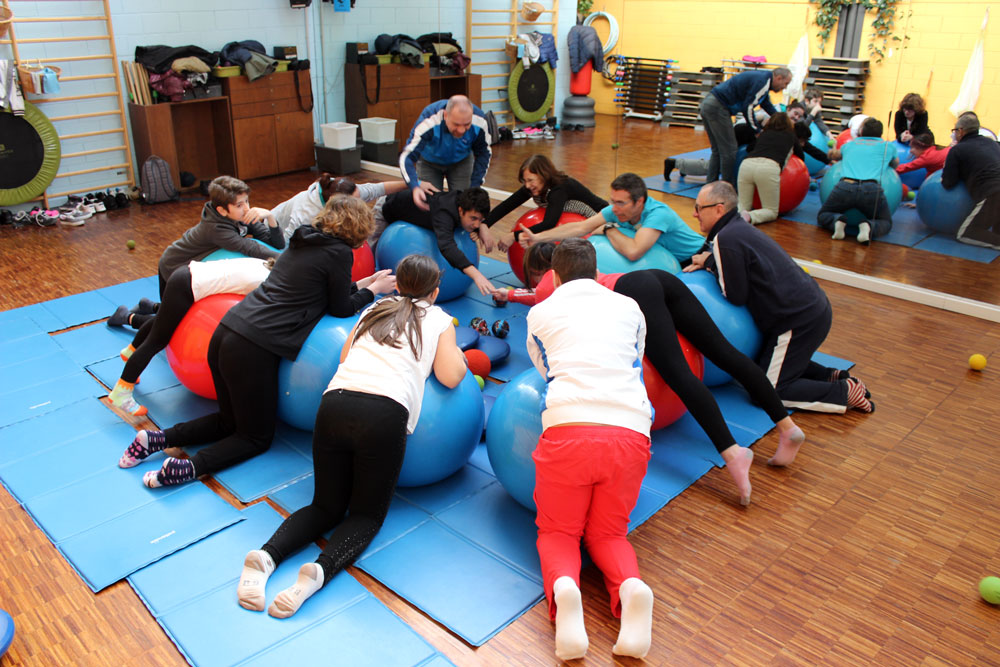 The Project
The Project
“Diverti(rsi) … Tempo” (Time to have fun) is the project in which we participated, bringing our experience as members of the Seregno Rugby medical staff to the development of preventive protocols for Sport, with the support of the Bodyworks-TPM staff.
The project, supported by the Community non-profit Foundation of Monza and Anffas Seregno (ITALY), aims to develop activities and spaces where leisure of disabled kids is an opportunity to improve relations with other kids without disabilities, thus allowing for real social inclusion. The part of the project managed by us involves the use of PEC (Proprioceptive Equilibrium Coordination) programs for a group of autistic teenagers accompanied by some of their friends, with the intent of ” mixing” the different abilities of the participants. The assumption is that if the kids just had fun, it would fill them with joy thus having achieved the purpose of the project. In our group there was the will, desire, and effort to try and put them in the circumstance of helping themselves acquire increased motor pattern skills to improve their movement coordination, which would then help them in everyday life.
Proprioception Equilibrium Coordination (PEC) Programs
(Propriocettivita Equilibrio Coordinazione)
Proprioception
The proprioceptive system is our body’s ability to receive and listen to sensory stimuli from the body and surrounding environment. This information needs to then be processed as quickly as possible so that it can inform skillful and graceful motor patterns of posture and movement, and protect our bodies from injury that might otherwise result from sudden and accidental changes of movement during physical activity.
The proprioceptive system is a real network made up of receptors located within muscles and tendons, joints, ligaments, and other connective fascia, that are all interconnected with the central nervous system. Acting through our subconscious, it makes us aware of our body’s position and movement through the space in which we live, implementing adaptations and modifications, which are the consequent answers that our body processes to address changing situations of the surrounding environment.
For instance, this network system manages and controls independently all of those situations in which we do things automatically, starting from simple activities such as walking, running, cycling, or climbing a ladder, to those activities requiring a finer and more complex set of skills such as drawing with a pencil, cutting something by using scissors, tying shoelaces, or peeling an apple.
Proprioceptive Training
The proprioceptive system, however, needs to be trained and stimulated continuously because it is subjected to “proprioceptive lethargy,” as Alexander pointed out. All routine situations that do not cause specific motor/neuromuscular stresses lower our body’s defense system, making it settle and adapt to repetitive gestures or movements. This lethargy context increases the chance that the corpuscles-organs-receptor of the network system appointed to proprioception become dormant and may interact poorly with the surrounding environment.
A simple example is the classic ankle inversion sprain caused by a small obstacle or a rough surface, which in a clumsy individual results in a tendency to fall. Struggling to perform this type of low-skill activity can indeed be a warning that the proprioceptive system is not very responsive. That’s why PEC programs act as a warning. Proprioceptive training programs must be continually practiced, both in sport and in everyday life, to protect us from the possible risks of physical injuries caused by the surrounding environment.
PEC and AUTISM
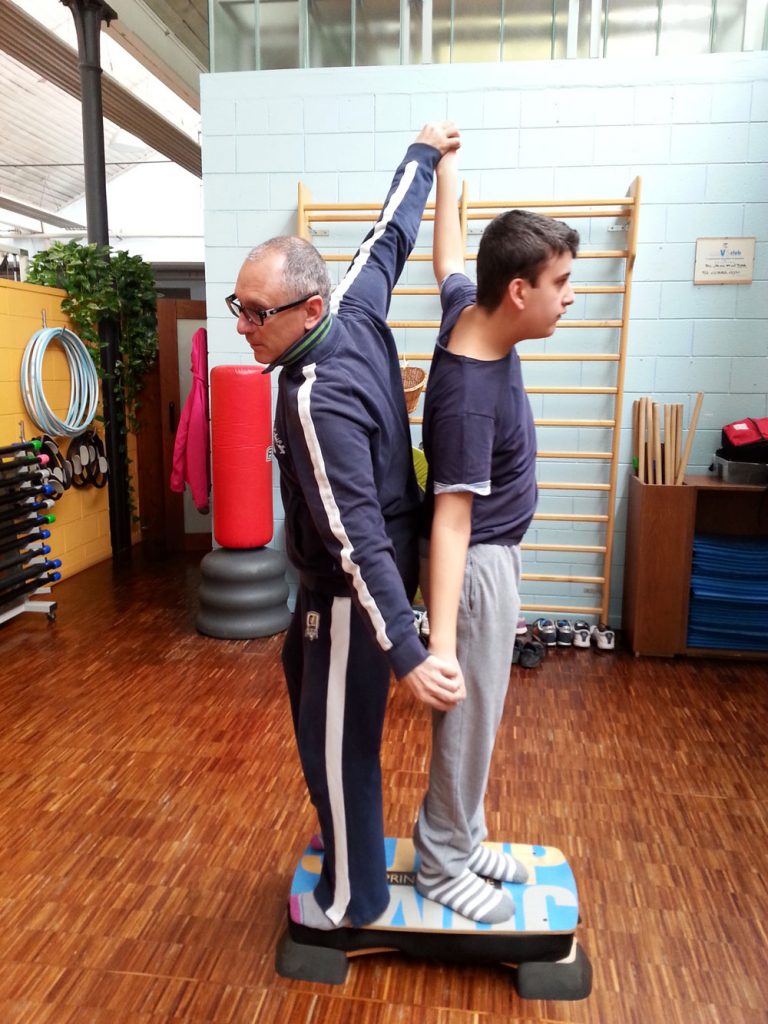 In order to challenge the body’s proprioceptive system, we create instability, using a range of tools including mats, foam and rubber balls of varying densities, colors, and sizes, Swiss balls, Freeman tables with air cushions, steppers, trampolines, gymnastic rods, hula-hoops, elastic bands, and all the tools that seemed useful as we progressed.
In order to challenge the body’s proprioceptive system, we create instability, using a range of tools including mats, foam and rubber balls of varying densities, colors, and sizes, Swiss balls, Freeman tables with air cushions, steppers, trampolines, gymnastic rods, hula-hoops, elastic bands, and all the tools that seemed useful as we progressed.
The exercises were performed trying to take advantage of all possible positions for the kids: standing, sitting and/or lying; and all possible positions/movements: static positions, movements, mixed positions performed in a circuit, individually, paired or in groups, and with and without footwear (as shown by some of the accompanying images).
PEC programs are particularly valuable for autistic children because they often have self-awareness difficulties in adapting the position of their bodies in space, not knowing how to handle the speed, intensity and duration of a movement, and/or and the amount of force required to move or throw an object.
 We then explored all possible situations, normal or unexpected, that could happen in everyday life linked with proprioceptive balance and coordination. We compared them with the PEC exercises and included the most difficult ones among those preferred by the kids. I would like to clarify the definition of an “easy” or “difficult” exercise, since such an evaluation is different according to the individual’s skills: all tests require a certain amount of effort which may determine, for each individual, whether the exercise is either “easy” or “difficult.” However, it is of paramount importance that one should never become “good” at proprioceptive exercises.
We then explored all possible situations, normal or unexpected, that could happen in everyday life linked with proprioceptive balance and coordination. We compared them with the PEC exercises and included the most difficult ones among those preferred by the kids. I would like to clarify the definition of an “easy” or “difficult” exercise, since such an evaluation is different according to the individual’s skills: all tests require a certain amount of effort which may determine, for each individual, whether the exercise is either “easy” or “difficult.” However, it is of paramount importance that one should never become “good” at proprioceptive exercises.
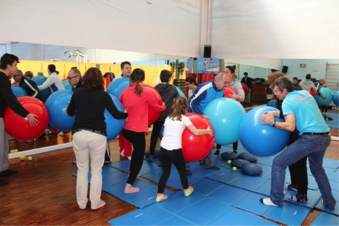 It might appear as a paradox, but if one stayed on a Freeman board on one foot for several minutes every day, while juggling three tennis balls, one would lapse into routine with the lethargy consequences explained above.
It might appear as a paradox, but if one stayed on a Freeman board on one foot for several minutes every day, while juggling three tennis balls, one would lapse into routine with the lethargy consequences explained above.
One must be careful never to become good at these exercises. It is important to always be challenging the child. Therefore something that creates instability should be included, like new obstacles that trigger new stimuli, or unexpected events, to always keep the proprioceptive network system alerted.
I found it amazing, upon the first experience of autism-physical activity, to see how these kids, who had varying levels of disability, naturally adapted to many “difficult exercises.”
Challenges of Autism
Autism undoubtedly manifests interpersonal difficulties with other people within groups. Nevertheless, I was wonderfully surprised by the empathy shown by the group, which helped to bring out their athletic abilities, often met with great satisfaction by their parents. I am not a psychologist, but I believe that having an open, helpful, and supportive attitude toward those around you, especially if they have psycho-motor skills problems, is stimulating for them to do well in the demanding physical and athletic exercises of a PEC program.
It really helped these kids to see how their friends and even the staff encountered the same challenges in order to succeed in the exercises. Despite being simple exercises, performing them in precarious balance conditions or with a non-ordinary posture can be challenging for anyone. We used the friendship among the children as a stimulus to attract their attention. I learned that this is the first step that one should take with autistic children before beginning with any activity. For an autistic child, relational problems are an obstacle, but following the advice of parents and educators was critical in order to get their attention and obtain remarkable results.
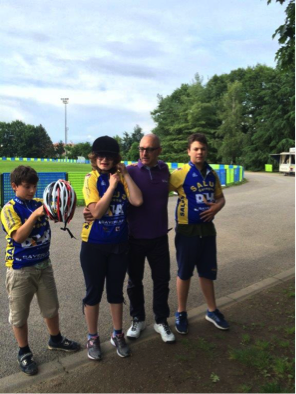 The types of PEC exercises used were very diverse. We tried to use exercises which were fun, but at the same time demanding. We used a wide spectrum of proprioceptive stimuli: at first for static phases, then we progressively moved on to using circuits with various types of exercises and stimuli that differed from one another. Afterward, we planned meetings to assess specific physical or postural problems for each child, not just those with disabilities. These meeting were the most challenging part of the PEC program, both physically and mentally.
The types of PEC exercises used were very diverse. We tried to use exercises which were fun, but at the same time demanding. We used a wide spectrum of proprioceptive stimuli: at first for static phases, then we progressively moved on to using circuits with various types of exercises and stimuli that differed from one another. Afterward, we planned meetings to assess specific physical or postural problems for each child, not just those with disabilities. These meeting were the most challenging part of the PEC program, both physically and mentally.
I will affirm from this experience a great mutual collaboration between people in need. Each one of us knows when our friend is finding it difficult to perform an exercise; and this solidarity is shown by lending a helping hand, for example by bringing balance boards closer together helping to lift a foot off the ground, or simply by standing next to our friend, showing that despite challenges and difficulties, things can be accomplished together. 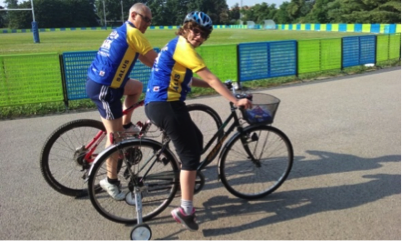 On the matter of physical contact, it was always fun when we simulated a rugby scrum, using a swiss-ball as a protection bag.
On the matter of physical contact, it was always fun when we simulated a rugby scrum, using a swiss-ball as a protection bag.
We tried to pass on a message that is so dear to rugby: support!
Support is more psychological rather than material. You know you are not alone. Just like during a rugby scrum where, after one team pushes against the other, inevitably displacements and rotations happen due to the force created by the teams pushing.
Therefore one can suddenly be in a pushing position and then in the opposite one trying to contrast the other’s pushing by resisting their force. This always happens while the single players “look for” support from team mates who take part in the scrum. The Swiss balls made everything more exciting and helped protect from potential injuries. Needless to say, the scrum was one of the most exciting, fun, noisy, and most requested preparatory exercises.
By nature, kids are inclined to look for security and physical support from those around them. Although we wanted to foster a sense of camaraderie, we worked hard to minimize this “support” effect, allowing it to happen only in case of real difficulties and for the relational aspect of physical bonds. This allowed each child to learn to become more individually competent.
Conclusion
Knowing the problems of autistic children in relating with others, we successfully sought to get them involved in PEC exercises, relying on their curiosity by turning on the desire to try to do what everyone in the room would subsequently do. We never even thought that they felt unable or uncomfortable during the exercises because, as I have already mentioned, they are not thought to be easy for anyone.
As the project came to an end, we had a fun finale on bicycles. Given the excellent results of balance and coordination, toward the end of our meetings, we wanted to test the children’s motor skills with a gym bike. It was not particularly difficult for them, they just had to get on and ride, first forward for a few minutes, then backward for a few minutes, and then get off. The problem that arose was that they did not want to get off! So to all the remaining meetings we added pedaling exercises on a gym bike for about 5 to 10 minutes.
Given the positive feedback, we endeavored to get them to ride on a real bike.
As chance would have it, one of the assistants of the project, Marino Valtorta, is a team manager and collaborator of the Italian Cycling Federation, who immediately obtained the necessary permits and procured bikes with training wheels that could support the kids’ weight. With great success, we were able to get them to ride on a track!
Most of their initial fears disappeared because the kids mastered cycling very quickly. To use Marino’s words: “it was a great victory!”
We are certain that there have been positive effects on the kids. We are confident that this awoke their ability to perceive many external stimuli and that their proprioceptive network is now more prepared to give faster and more functional responses by using the most appropriate motor patterns for daily situations that involve coordination and balance dexterity.
At the conclusion of our project, I was asked to extend the duration of the project for the entirety of 2017! Something we looked forward to with great joy and anticipation!
Being involved in the PEC programs was a very positive experience for all participants. It also helped me grow technically, professionally, and on a personal level!
Acknowledgments
Thank you to: Mauro Brambilla, President of Anffas Seregno who strongly desired that I become involved in this project. And great appreciation to all the parents of the children, as well as the childrens’ assistants and friends: Enzo, Sabrina, Davide, Marino, Letizia, Melissa, Roberto, Mario. Also thank you to the Elisa, the educator involved with our project. And to Piera and Massimo Terragni, owners of CobraGym FitnessClub, and the medical staff of Seregno Rugby. And finally, thank you to all the people involved who wanted to see how the PEC-autism project developed.
THANK YOU!
This article was written by by Maurizio Ronchi *,
in collaboration with Elisa Volontè ** and Federico Polimene ***,
* Maurizio Ronchi, Bodyworker sports and medical staff coordinator Seregno Rugby, teacher in Bodyworks-TPM
** Federico Polimene, MFT, fitness coach and the medical staff member Seregno Rugby, teacher in Bodyworks-TPM
*** Dr. Elisa Volonte, professional educator
BIBLIOGRAPHY
1, M Ronchi, Gibin M, J Masera, Polimene F, Zecchinello F., PEC – Proprioceptivity, Balance, Coordination: prevention programs, and riatletizzazione sportbodyworks – FITMEDonline year 2 n. 11-12, 2010; year 3 n. 1, 2011
If anyone is interested in this project, the PEC protocol or further information, please contact:
Maurizio Ronchi:
email: info@bodyworks-tpm.it
Researcher in the development of myofascial techniques and protocols that prevent sports injuries and for post-therapy athletic rehabilitation.
Holistic practitioner, non therapist sports bodyworker, populariser and lecturer for Bodyworks-TPM, coordinator of the Seregno Rugby medical staff, member of Associazione Manipolazione Fasciale® and the Associazione Italiana Taping Kinesiologico®, FIDAL instructor (Italian Athletics Federation), MBT posture instructor (Masai Barefoot Technology). APODIB member – Association of Professional Bionatural Disciplines Operators.
The use of this work, or parts of it, is free as long as the author and the source are quoted. If needed, all of the author’s articles are available in their entirety in digital format.
This blog post article was created with collaboration of www.terrarosa.com.au.
(Click here for the blog post article on Neural Plasticity – Learning Posture and Movement Patterns.)

